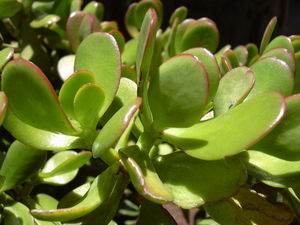Jade plants (also sometimes called Friendship Trees) have been popular as houseplants for many years. The popularity of Jade plants comes from their unique look, as well as their ease of growth and propagation. Originally from South Africa, the Jade plant is native to dry, sunny conditions. Therefore, it can easily handle long periods between waterings.
Jade plants grow slowly, but can live for decades. Under good conditions, a Jade plant will usually grow to be around 5 feet tall, but can grow even taller. When they are young, Jade plants have fleshy green stems with green leaves growing in opposing pairs. As they grow older, the stems become brown and more like the trunk of a tree. When they are mature, Jade plants will sometimes flower in winter. Their small star-shaped flowers are usually pink or white and appear in clusters.
Propagating Jade Plants
Jade plants are very simple to propagate, which is one of the reasons they are so popular. Jade plants are propagated from leaves or stems, so it is best to propagate from a mature plant that can tolerate losing a couple of leaves or a bit of stem. To propagate from a leaf cutting, remove a leaf or two from the plant. Make sure to break the leaf off right at the stem. Simply set the leaves on top of a pot of soil (preferably a quick draining potting soil, the type made for succulents). The leaf should put down roots within a week or so, and a new plant will begin growing after a month or two. The plant will be tiny, and will grow slowly, but it really couldn’t be any easier to do!
If you want a bigger plant, and you want it quicker, try a stem cutting. Make sure you take the cutting from an older plant, since removing part of a stem can be a bit of a shock for a young plant. Use a sharp knife or blade to cut the stem. Don’t use scissors, as the cut usually won’t be clean enough. Cut just below a stem joint, so the joint is part of the cutting. Let the cutting sit out for a few days so a callous will form on the end. Once the callous is formed, plant the end about one and a half inches into moistened soil, in the pot you plan on growing the new plant in. After planting, let the soil dry before watering again. With either a leaf or a stem cutting, keep the soil temperature around 75 to 80 degrees for best results.
Growing Conditions
Jade plants are as easy to grow as they are to propagate. They can tolerate a good deal of sun, although direct sun all day isn’t recommended. Don’t put them in complete shade, either, but they will be fine getting indirect light. Their leaves can tend to get dusty, so it is a good idea to dust them off every now and then. Let the soil dry completely between waterings. Although they need more water than a cactus, a Jade plant being grown as a houseplant is more likely to be killed by too much water than too little.
Pests
Very few pests bother Jade plants, although you should keep an eye out for mealy bugs, which can be identified by a white cotton-like covering on the stems or underside of the leaves. Mealy bugs can be hard to fight, and a serious infestation usually results in the plant having to be discarded. If the infestation is minor, the white cotton cocoons can be removed with a Q-Tip dipped in rubbing alcohol.
Jade plants are a very rewarding house plant. Even if the conditions are not ideal, a plant will usually last for many years, even decades, and grow into a real showpiece. Plus, since they are so easy to propagate, it is easy and cheap to grow several plants, or give cuttings to friends and relatives. Having houseplants can instantly brighten any room, and Jade plants are perfect for anybody whether they have a green thumb or not!



